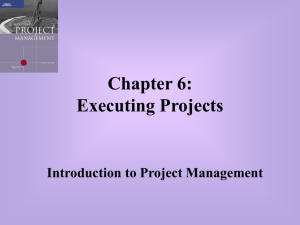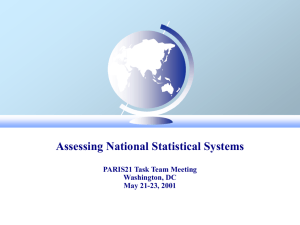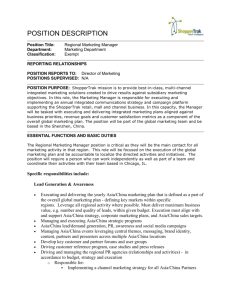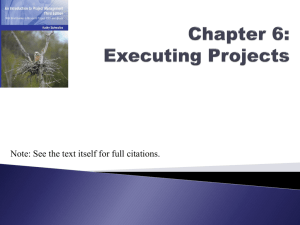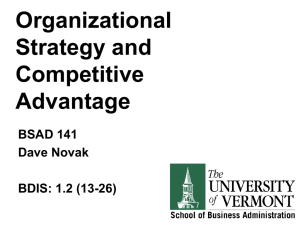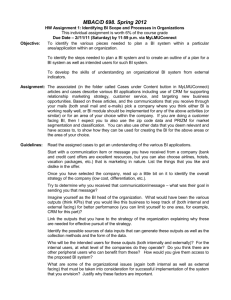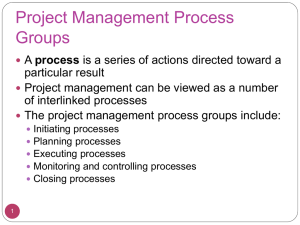Chapter 6: Executing Projects Learning Objectives Introduction to Project Management
advertisement
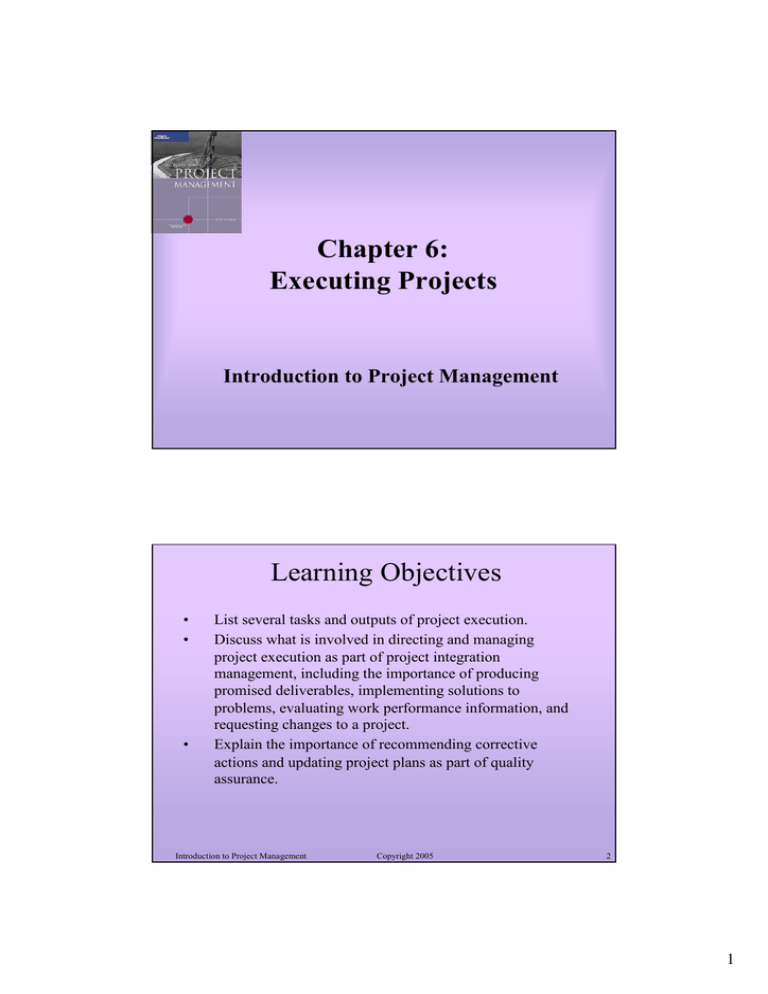
Chapter 6: Executing Projects Introduction to Project Management Learning Objectives • • • List several tasks and outputs of project execution. Discuss what is involved in directing and managing project execution as part of project integration management, including the importance of producing promised deliverables, implementing solutions to problems, evaluating work performance information, and requesting changes to a project. Explain the importance of recommending corrective actions and updating project plans as part of quality assurance. Introduction to Project Management Copyright 2005 2 1 Learning Objectives (continued) • Describe the executing tasks performed as part of human resource management, summarize important concepts related to managing people, and explain what is involved in creative staffing updates and team performance assessments. • Discuss important communications concepts, and describe the executing tasks performed as part of communications management to ensure good communications. • Explain the executing tasks performed as part of procurement management, and describe how to prepare procurement document packages and contracts. Introduction to Project Management Copyright 2005 3 Introduction • Project execution is the most noticed process group. • Research shows that without a doubt, the main reason CEOs failed was poor execution; the same is true for project managers. • Recall that, in general, the majority of a project’s time and budget is spent on project execution. • Many of the tasks and outputs created in the other process groups are fairly similar from project to project, but no two projects are ever executed in the exact same way due to uncertainties and unique challenges. Introduction to Project Management Copyright 2005 4 2 What Went Wrong? “The results are not acceptable,” stated President Bush four days after Hurricane Katrina caused major damage to New Orleans and surrounding areas. After Federal Emergency Management Agency (FEMA) officials returned in January 2005 from a tour of the tsunami devastation in Asia, New Orleans was the number one disaster they discussed. Officials had drawn up dozens of plans and conducted preparedness drills for years, but despite all the warnings, Hurricane Katrina overwhelmed government agencies, and many people suffered from slow response to their needs for emergency aid. The mayor of New Orleans, C. Ray Nagin, blasted the government for its lack of an immediate response. “I’ve talked directly with the President, I’ve talked to the head of the Homeland Security, I’ve talked to everybody under the sun, I’ve been out there.”* People were disappointed with the poor execution of disaster relief efforts during the first few days, and officials took corrective actions to address the challenges caused by the hurricane. Shadi Rahimi, “Bush Embarks on Tour to Survey Damage,” The New York Times (September 2, 2005). Introduction to Project Management Copyright 2005 5 Figure 6-1. On a Lighter Note: All For the Team’s Execution? Introduction to Project Management Copyright 2005 6 3 Table 6-1. Executing Process Summary Introduction to Project Management Copyright 2005 7 Executing Tasks for Project Integration Management • To direct and manage project stakeholders, project managers can follow several important practices: – – – – – Coordinate planning and execution . Develop and use soft skills. Provide a supportive organizational culture. Break the rules when needed. Capitalize on product, business, and application area knowledge. – Use project execution tools and techniques. Introduction to Project Management Copyright 2005 8 4 Deliverables • Most project sponsors would say that the most important output of any project is its deliverables. • Recall that deliverables are products or services produced or provided as part of a project. • For the Just-In-Time Training project at Global Construction, key deliverables include: – Training materials and courses (instructor-led, Webbased, and CD-ROM). – Deliverables related to developing and delivering those training materials and courses, such as surveys, design documents, prototypes, and meetings. Introduction to Project Management Copyright 2005 9 Implemented Solutions to Problems • Of course, all project teams face numerous problems. • Some problems can be avoided by doing a good job of initiating, planning, or monitoring and controlling the project, but other problems cannot be avoided. • Some common problems encountered during project execution are described in this chapter, but project managers must be creative and flexible in dealing with problems that occur on their projects. Introduction to Project Management Copyright 2005 10 5 Common Problems During Execution • The project sponsor and/or other senior managers are not very supportive of the project. • Project stakeholders, such as people who would use the products and services the project is attempting to create, are not sufficiently involved in project decision-making. • The project manager is inexperienced in managing people, working in a particular organization, or understanding the application area of the project. Introduction to Project Management • The project objectives/scope are unclear. • Estimates for time and cost goals are unreliable or unrealistic. • Business needs/technology changes have impacted the project. • People working on the project are incompetent or unmotivated. • There are poor conflictmanagement procedures. • Communications are poor. • Suppliers are not delivering as promised. Copyright 2005 11 Sample Implemented Solution to Problems • Kristin Maur encountered several problems during execution, such as: – Incompetent or unmotivated people working on the project. – Poor conflict-management procedures. Introduction to Project Management Copyright 2005 12 6 Issues with Competence and Motivation • Although Jamie was assigned to work on the Just-InTime Training project from its start, she was on vacation for most of the first month and seemed uninterested in the project when she was around. • Kristin tried her best to motivate Jamie, but Jamie was simply not the right person for the project. • Kristin talked to Jamie directly (using the confrontation approach), and Jamie admitted that she would much rather deal directly with suppliers than work on this project. • Kristin replaced Jamie with someone more suitable. Introduction to Project Management Copyright 2005 13 Poor Conflict Management • Most large projects are high-stake endeavors that are highly visible within organizations. • When the stakes are high, conflict is never far away, and even small projects with low budgets have conflicts— it is a natural part of work and life in general. • Project managers should lead their teams in developing norms for dealing with various types of conflicts that might arise. Introduction to Project Management Copyright 2005 14 7 Conflict Handling Modes, in Preference Order • • Blake and Mouton (1964) delineated five basic modes for handling conflicts. Each strategy can be considered as being high, medium, or low on two dimensions: importance of the task or goal, and importance of the relationship between the people having the conflict (high/low, medium/medium, and so on). 1. Confrontation or problem-solving: Directly face a conflict (high/high). 2. Compromise: Use a give-and-take approach (medium/medium). 3. Smoothing: De-emphasize areas of differences and emphasize areas of agreement (low/high). 4. Forcing: The win-lose approach (high/low). 5. Withdrawal: Retreat or withdraw from an actual or potential disagreement (low/low). Introduction to Project Management Copyright 2005 15 Conflict Can Be Good • Conflict often produces important results, such as new ideas, better alternatives, and motivation to work harder and more collaboratively. • Project team members might become stagnant or develop groupthink— conformance to the values or ethical standards of a group— if there are no conflicting viewpoints on various aspects of a project. • Research suggests that: – Task-related conflict, which is derived from differences over team objectives and how to achieve them, often improves team performance. – Emotional conflict, however, which stems from personality clashes and misunderstandings, often depresses team performance. Introduction to Project Management Copyright 2005 16 8 Work Performance Information • During project execution, project managers must collect, assess, and communicate work performance information. • Many project managers, like Kristin, use the “management by wandering around” (MBWA) approach, meaning they informally observe and talk to project team members, suppliers, and other stakeholders as much as possible. • Kristin also used formal communications, such as status reports, survey results, and course evaluations, to address work performance on the project. Introduction to Project Management Copyright 2005 17 Sample Work Performance Information • A common way to summarize work performance information is by using a milestone report. • Recall that a milestone is a significant event on a project, such as completing a major deliverable or awarding a major contract. • In addition to listing the milestones, the report lists the planned date for completion (in month/day format), the status, the person responsible for the milestone, and issues/comments. Introduction to Project Management Copyright 2005 18 9 Table 6-2. Sample Milestone Report for Reporting Work Performance Information Introduction to Project Management Copyright 2005 19 Requested Changes • Often, a number of requests for changes emerge during project execution. • Recall that a process for handling changes should be defined during project planning as part of the project management plan. • It is important during project execution to formally and informally request appropriate changes. Introduction to Project Management Copyright 2005 20 10 Table 6-3. Sample Change Request Introduction to Project Management Copyright 2005 21 Executing Tasks for Project Quality Management • Quality assurance includes all the activities related to satisfying the relevant quality standards for a project. • Another goal of quality assurance is continual quality improvement. • Key outputs of quality assurance include recommended corrective actions and project plan updates. Introduction to Project Management Copyright 2005 22 11 Quality Improvement Techniques • Benchmarking generates ideas for quality improvements by comparing specific project practices or product characteristics to those of other projects or products within or outside of the organization itself (for example, training costs per employee and course ratings are benchmarks). • A quality audit is a structured review of specific quality management activities that helps identify lessons learned, which could improve performance on current or future projects. • Cause-and-effect diagrams— also called fishbone diagrams (because their structure resembles a fishbone) or Ishikawa diagrams (named after their founder)— can assist in ensuring and improving quality by finding the root causes of quality problems. Introduction to Project Management Copyright 2005 23 Sample Recommended Corrective Actions • Problem: The prototype supplier management course had less than 3.5 ratings. • Approach: Kristin’s team reviewed the course evaluations and contacted some course participants to find that the CD/ROM course was the source of the low ratings. They created a cause-and-effect diagram to find the root cause of those low ratings. • Solution: They recommended that the discussion board and chat room features of the Web-based course be integrated into the CD-ROM course to improve interactivity. Introduction to Project Management Copyright 2005 24 12 Figure 6-2. Sample Cause and Effect Diagram Introduction to Project Management Copyright 2005 25 Executing Tasks for Project Human Resource Management • Effective project human resource management is crucial to project execution. • The two main tasks project managers perform include acquiring the project team and developing the project team. • Key outputs include staffing updates and team performance assessments. Introduction to Project Management Copyright 2005 26 13 Motivation • Project managers must understand motivation theories to effectively execute projects. • Psychologists, managers, coworkers, teachers, parents, and most people in general still struggle to understand what motivates people, or why they do what they do. • Intrinsic motivation causes people to participate in an activity for their own enjoyment. • Extrinsic motivation causes people to do something for a reward or to avoid a penalty. • Maslow suggested that people’s behaviors are guided or motivated by a sequence of needs. Introduction to Project Management Copyright 2005 27 Figure 6-3. Maslow’s Hierarchy of Needs Introduction to Project Management Copyright 2005 28 14 Herzberg’s Motivational and Hygiene Factors • Frederick Herzberg wrote several famous books and articles about worker motivation. He distinguished between the following: – Motivational factors: Factors that cause job satisfaction, such as achievement, recognition, the work itself, responsibility, advancement, and growth. – Hygiene factors: Factors that cause dissatisfaction if not present, but do not motivate workers to do more. Examples include larger salaries, more supervision, and a more attractive work environment. Introduction to Project Management Copyright 2005 29 McClelland’s Acquired-Needs Theory • Specific needs are acquired or learned over time and shaped by life experiences, including: – Achievement (nAch): People with a high need for achievement like challenging projects with achievable goals and lots of feedback. – Affiliation (nAff): People with high nAff desire harmonious relationships and need to feel accepted by others, so managers should try to create a cooperative work environment for them. – Power: (nPow): People with a need for power desire either personal power (not good) or institutional power (good for the organization). Managers should provide institutional power seekers with management opportunities. Introduction to Project Management Copyright 2005 30 15 McGregor’s Theory X and Y • Douglas McGregor popularized the human relations approach to management in the 1960s. • Theory X: Assumes workers dislike and avoid work, so managers must use coercion, threats and various control schemes to get workers to meet objectives. • Theory Y: Assumes individuals consider work as natural as play or rest and enjoy the satisfaction of esteem and self-actualization needs. Introduction to Project Management Copyright 2005 31 Thamhain and Wilemon’s Ways to Have Influence on Projects 1. Authority: The legitimate hierarchical right to issue orders. 2. Assignment: The project manager's perceived ability to influence a worker's later work assignments. 3. Budget: The project manager's perceived ability to authorize others' use of discretionary funds. 4. Promotion: The ability to improve a worker's position. 5. Money: The ability to increase a worker's pay and benefits. Introduction to Project Management Copyright 2005 32 16 Thamhain and Wilemon’s Ways to Have Influence on Projects (continued) 6. Penalty: The project manager's ability to cause punishment. 7. Work challenge: The ability to assign work that capitalizes on a worker's enjoyment of doing a particular task. 8. Expertise: The project manager's perceived special knowledge that others deem important. 9. Friendship: The ability to establish friendly personal relationships between the project manager and others. Introduction to Project Management Copyright 2005 33 Ways to Influence that Help and Hurt Projects • Projects are more likely to succeed when project managers influence with the following: – Expertise – Work challenge • Projects are more likely to fail when project managers rely too heavily on the following: – Authority – Money – Penalty Introduction to Project Management Copyright 2005 34 17 Effectiveness • Project managers can apply Stephen Covey’s 7 habits to improve effectiveness on projects. – – – – – – – Be proactive. Begin with the end in mind. Put first things first. Think win/win. Seek first to understand, then to be understood. Synergize. Sharpen the saw. Introduction to Project Management Copyright 2005 35 Empathic Listening and Rapport • Good project managers are empathic listeners— they listen with the intent to understand. • Before you can communicate with others, you have to have rapport— a relation of harmony, conformity, accord, or affinity. • Mirroring is the matching of certain behaviors of the other person, a technique to help establish rapport. Introduction to Project Management Copyright 2005 36 18 What Went Right? • A young business consultant who worked in the IT department of a major aerospace firm met with a senior project manager and his core team. The project involved providing updated electronic kits for a major aircraft program. The company was losing money on the project because the upgrade kits were not being delivered on time. Most buyers had written severe latepenalty fees into their contracts, and other customers were threatening to take their business elsewhere. The project manager blamed it all on the IT department for not letting his staff access the information system directly to track the status of kit development and delivery. The tracking system was old and difficult to use. The business consultant was warned that this project manager was very difficult to work with. When the project manager entered the meeting room with three of his staff, all older men, he threw his books on the table and started yelling at the young consultant and her even younger assistant. Instead of backing down, the consultant mirrored the project manager’s behavior and started yelling right back at him. He stood back, paused, and said, “You’re the first person who’s had the guts to stand up to me. I like that!” After that brief introduction, rapport was established, and everyone began communicating and working together as a team to solve the problem at hand. Introduction to Project Management Copyright 2005 37 Acquiring the Project Team and Making Staffing Updates • There’s a saying that the project manager who is the smartest person on the team has done a poor job of recruiting! • After developing a staffing management plan during project planning, project managers must work with other managers in their organizations to assign personnel to their project or to acquire additional human resources. • Managers must also motivate their staff and remember why people choose to leave their jobs. Introduction to Project Management Copyright 2005 38 19 Top Three Reasons People Leave Their Jobs (from Fast Company Study) 1. They feel they do not make a difference. 2. They do not get proper recognition. 3. They are not learning anything new or growing as a person. • Managers can ensure these reasons do not occur by doing a good job of motivating and managing their people. Introduction to Project Management Copyright 2005 39 Sample Staffing Updates • To keep everyone up-to-date on current project staffing assignments, Kristin provided a current team roster on the project Web site and included team member names, roles, and contact information. • As suppliers were added to the project, she included supplier staff information as well. Introduction to Project Management Copyright 2005 40 20 Table 6-4. Sample Team Roster Introduction to Project Management Copyright 2005 41 Developing the Project Team and Assessing Team Performance • Many failed projects have been staffed by highly talented individuals; however, it takes teamwork to complete projects successfully. • The main goal of team development is to help people work together more effectively to improve project performance. • Project managers should understand and apply good team-building practices because it takes teamwork to successfully execute most projects. Introduction to Project Management Copyright 2005 42 21 Tuckman Model of Team Development • • • • • Forming Storming Norming Performing Adjourning Introduction to Project Management Copyright 2005 43 Training • Project managers often recommend that people take specific training courses to improve individual and team development. • Team-building activities include using physical challenges and psychological preference indicator tools, such as the Meyers-Briggs Type Indicator and the Wilson Learning Social Styles Profile. Introduction to Project Management Copyright 2005 44 22 Meyers-Briggs Type Indicator (MBTI) • MBTI is a popular tool for determining personality preferences and helping teammates understand each other. • Four dimensions include: – – – – Extrovert/Introvert (E/I) Sensation/Intuition (S/N) Thinking/Feeling (T/F) Judgment/Perception (J/P) • NTs or rationals are attracted to technology fields. • IT people vary most from the general population in not being extroverted or sensing. Introduction to Project Management Copyright 2005 45 Social Styles Profile • People are perceived as behaving primarily in one of four zones, based on their assertiveness and responsiveness: – – – – Drivers Expressives Analyticals Amiables • People on opposite corners (drivers and amiables, analyticals and expressives) may have difficulties getting along. Introduction to Project Management Copyright 2005 46 23 Figure 6-4. Social Styles of Wilson Learning Introduction to Project Management Copyright 2005 47 Reward and Recognition Systems • Team-based reward and recognition systems can promote teamwork. • Focus on rewarding teams for achieving specific goals. • Allow time for team members to mentor and help each other to meet project goals and develop human resources. Introduction to Project Management Copyright 2005 48 24 Sample Team Performance Assessment • Project managers assess team performance in several ways. – Kristin believed in management by wandering around, and she liked to have many short, informal discussions with various stakeholders, especially her project team members. – She also observed people working alone and as a team, and assessed the quality of deliverables they produced. – Kristin periodically asked her project team members to fill out self-assessments to assist in performance assessment; she discussed each person’s assessment and took corrective actions as needed. – Kristin and other project managers at Global Construction also filled out performance appraisals for each team member once a year or when a project was completed. Introduction to Project Management Copyright 2005 49 Table 6-5. Sample Team Performance Assessment Introduction to Project Management Copyright 2005 50 25 Executing Tasks for Project Communications Management • Good communications management is also crucial to project execution. • Information distribution is the main communications management task performed during project execution. • The main output of this task is updating business processes. Introduction to Project Management Copyright 2005 51 Important Project Communications Concepts • Some project managers say that 90 percent of their job is communicating; therefore, it is important to address important concepts related to improving project communications. • Key concepts include: – – – – Formal and informal communications Nonverbal communications Using the appropriate communications medium Understanding individual and group communication needs – The impact of team size on project communications Introduction to Project Management Copyright 2005 52 26 Formal and Informal Communications • It is not enough for project team members to submit formal status reports to their project managers and other stakeholders and assume that everyone who needs to know that information will read the reports. • In fact, many people may prefer to have an informal, two-way conversation about project information. • Project managers must be good at nurturing relationships through good communication. Introduction to Project Management Copyright 2005 53 Nonverbal Communications • Research poses the theory that in a face-to-face interaction, 58 percent of communication is through body language, 35 percent is through how the words are said, and a mere 7 percent is through the content or words that are spoken. The author of this information (see Silent Messages by Albert Mehrabian, 1980) was careful to note that these percentages were specific findings for a specific set of variables. • Even if the actual percentages are different in verbal project communications today, it is safe to say that it is important to pay attention to more than just the actual words someone is saying. • Nonverbal communications, such as a person’s tone of voice and body language, are often more important than the words being used. Introduction to Project Management Copyright 2005 54 27 Table 6-6. Media Choice Table Introduction to Project Management Copyright 2005 55 Media Snapshot • Although most projects do not use live video as a medium for sending project information, the technology is becoming more available and less expensive. You can reach many people at once using live video, and viewers can see and hear important information. For example, Microsoft had been experimenting with its new conferencing product, Livemeeting. Anoop Gupta, a vice president of Microsoft’s real-time collaboration group, says that one in every five face-to-face meetings can be replaced with Web conferencing tools, and Microsoft estimates that it will save $70 million in reduced travel for organizations worldwide in one year alone.* • However, any live communication broadcast can also backfire, especially if millions of people are watching. In fact, one event, Janet Jackson’s “wardrobe malfunction” during the 2004 Super Bowl in the United States, had a major impact on the entire broadcasting industry, causing television and radio stations to use several-second delays to prevent offensive video or audio from reaching the airwaves. Reuters reported on September 22, 2004, that the Federal Communications Commission had officially voted to fine each of the twenty stations owned by the CBS television network $27,500 for violating indecency rules. The fine was the maximum allowed by law at the time, and Congress is considering legislation to increase the fine to as much as $500,000 per incident.** *Steve Lohr, “Ambitious Package to Raise Productivity (and Microsoft’s Profit),” The New York Times (August 16, 2004). **Reuters, “TV Stations Fined for Janet Jackson Breast Flash,” http://www.reuters.com/ (September 22, 2004). Introduction to Project Management Copyright 2005 56 28 Understanding Individual and Group Communication Needs • People are not interchangeable parts. • As illustrated in Brooks’book, The Mythical ManMonth, you cannot assume that a task originally scheduled to take two months of one person’s time can be done in one month by two people; nine women cannot produce a baby in one month! • Individuals prefer different ways to communicate. • Geographic location and cultural backgrounds also affect communications. Introduction to Project Management Copyright 2005 57 The Impact of Team Size on Project Communications • As the number of people involved increases, the complexity of communications increases because there are more communications channels, or pathways, through which people can communicate. • Number of communications channels = n(n-1) 2 where n is the number of people involved. • For example, two people have one communications channel: (2(2– 1))/2 = 1. Five people have ten channels (5(5-1))/2=10. • As the number of people communicating increases, the number of communications channels increases rapidly, so it is often helpful to form several smaller teams within a large project team to help improve project communications. Introduction to Project Management Copyright 2005 58 29 Information Distribution and Updating Business Processes • Getting project information to the right people at the right time and in a useful format is just as important as developing the information in the first place. • During execution, project teams must address important considerations for information distribution. • The main output of information distribution is updating business processes, such as policies and procedures, guidelines, information systems, financial systems, management systems, lessons learned, and historical documents. Introduction to Project Management Copyright 2005 59 Sample Updates to Business Processes • Kristin and her team used instant messaging on a regular basis both within their team and with suppliers. • Several suppliers used Webcasts to communicate information in a more dynamic way without incurring travel expenses. • The Web-based courses that suppliers were developing for the project included discussion threads and an “Ask the Expert” feature, in which learners could ask specific questions of the instructor or experts within the company on various topics related to the course. • Kristin kept her own personal project blog to document important events and lessons she was learning while managing the project. • The project steering committee asked Kristin to prepare guidelines for using these new technologies effectively. Introduction to Project Management Copyright 2005 60 30 Executing Tasks for Project Procurement Management • The main executing tasks performed as part of project procurement include requesting seller responses and selecting sellers. • Key outputs include procurement document packages, contracts, and contract management plans. Introduction to Project Management Copyright 2005 61 Requesting Seller Responses, Qualified Sellers Lists, and Procurement Document Packages • Organizations can use several different methods to approach and select qualified sellers or suppliers: – Approaching a preferred supplier – Approaching several qualified suppliers – Advertising to many potential suppliers • A procurement document package generally includes a summary letter, a request for proposal or quote, and a contract statement of work. Introduction to Project Management Copyright 2005 62 31 Table 6-7. Sample Qualified Sellers List Introduction to Project Management Copyright 2005 63 Selecting Sellers and Writing Contracts • Selecting sellers, often called source selection, involves evaluating proposals or bids from sellers, choosing the best one, negotiating the contract, and awarding the contract. • Often, buyers develop a short list of the top three to five suppliers to reduce the work involved in selecting a source, and they are often asked to prepare a best and final offer (BAFO). • It is good practice to include a detailed statement of work and schedule as part of the contract to clarify exactly what work the seller will perform and when. Introduction to Project Management Copyright 2005 64 32 Table 6-8. Sample Contract Introduction to Project Management Copyright 2005 65 Chapter Summary • Executing outputs related to integration management includes deliverables, implemented solutions to problems, work performance information, and requested changes. • Executing outputs related to quality management includes recommended corrective actions and project plan updates. • Executing outputs related to human resource management includes staffing updates and team performance assessments. Project managers must also apply concepts related to motivation, influence, and effectiveness to lead people during project execution. • Executing outputs related to communications management consist of business process updates. Project managers must apply important concepts related to communications, such as formal and informal communications, nonverbal communications, the appropriate communications medium, individual and group communication needs, and the impact of team size on project communications. • Executing outputs related to procurement management includes procurement document packages and contracts. Introduction to Project Management Copyright 2005 66 33
